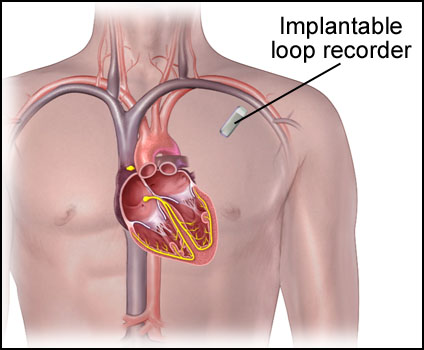Procedures
Implantable Loop Recorder (ILR)
If a patient is experiencing symptoms such as dizziness, fainting, or palpitations, an implantable loop recorder may help identify the underlying cause of these symptoms.
This is a small device that is implanted under the skin of the chest to continuously monitor the heart rhythm. This device can record and store information about the heart’s electrical activity, helping us to diagnose heart rhythm disorders that may be difficult to detect through traditional monitoring methods.
The implant procedure is a minimally invasive procedure and typically takes only a few minutes and is performed under local anaesthesia. Once implanted, the ILR can continuously monitor the heart rhythm for up to three years, providing valuable data that can help inform treatment decisions. It is MRI compatible and uses wireless one-way telemetry for remote monitoring. You can activate the device to capture a recording of your heart rhythm during symptoms to facilitate diagnosis of your arrhythmia.

Call for Appointment
(02) 9646 4044
Procedures Expertise
Coronary Angiography & Stenting
Everything you need to know about
Implantable Loop Recorder
Who needs an ILR?
ILRs may be recommended for patients who are experiencing symptoms such as dizziness, fainting, or palpitations that may be related to heart rhythm disorders.
What are the benefits of ILR implantation?
The benefits of ILR implantation include continuous, long-term monitoring of the heart rhythm, which can help diagnose heart rhythm disorders that may be difficult to detect through traditional monitoring methods. This can lead to more accurate diagnosis and personalised treatment options.
Is ILR implantation safe?
The implantation of an ILR is quite safe, with very minimal risks associated with the procedure. Your cardiologist will discuss any potential risks with you prior to the procedure.
How is an ILR implanted?
The implantation of an ILR is a minimally invasive hospital day stay procedure that is typically performed under local anaesthesia. It generally takes a few minutes. The device is placed under the skin of the chest using a small incision, and the procedure takes only a few minutes to complete.
What is the recovery time after ILR is implanted?
There is typically little to no recovery time after an implantable loop recorder (ILR) is implanted. The procedure is minimally invasive and typically does not require general anaesthesia, so most patients are able to resume their normal activities immediately following the procedure. However, it is important to follow any post-operative instructions provided by the Auburn Cardiology Centre team to ensure proper healing and to minimise the risk of complications.
How long can an ILR monitor the heart rhythm?
An implantable loop recorder can continuously monitor the heart rhythm for up to three years, providing valuable data that can help inform treatment decisions.
Will I feel the device once it is implanted?
Once the device is implanted, it should not be felt or cause discomfort. However, it is important to avoid activities that may cause excessive pressure or trauma to the implant site.
How is the data collected from the ILR?
The data collected from the ILR is transmitted wirelessly to a device that is kept at home. Our office will provide you with instructions on how to use the device and upload the data for analysis.
Can an ILR be removed?
Yes, an implantable loop recorder can be removed if it is no longer needed or if the battery has run out. The removal procedure is straightforward and done is generally simple and can be done on an outpatient basis. This is performed as a hospital day stay procedure.
Call for Appointment
(02) 9646 4044
Procedures Expertise
Coronary Angiography & Stenting
Book an Appointment
Call for appointment/GP referral
(02) 9646 4044
